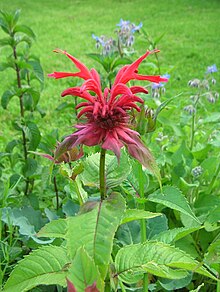Gold balm
| Gold balm | ||||||||||||
|---|---|---|---|---|---|---|---|---|---|---|---|---|

Golden balm ( Monarda didyma ) |
||||||||||||
| Systematics | ||||||||||||
|
||||||||||||
| Scientific name | ||||||||||||
| Monarda didyma | ||||||||||||
| L. |
The Bergamot ( Monarda didyma ), also Beebalm or scarlet-Monarde called, is a species of the genus Monarda in the family Labiatae (Lamiaceae).
features
The golden balm is a perennial , herbaceous plant with a rhizome that is not hardy in Central Europe but not hardy for a long time and reaches heights of 80 to 150 centimeters. The plant smells of lemon. The upright stems are square. The opposite leaves are simple, rough, and only short stalked. The leaf blade has a length of 15 cm and a width of 5 cm. The leaf margin is sawn.
About 30 flowers are grouped in terminal inflorescences with red bracts . The hermaphrodite flowers are zygomorphic and five-fold. The calyx is 10 to 14 millimeters long and glabrous or only slightly hairy on the throat. The red, hairy crown is 30 to 45 millimeters long. The crown upper lip is bald or only sparsely hairy. There are only two stamens . The style ends with two scar branches.
The flowering period extends from June to September.
The number of chromosomes is 2n = 32.
Occurrence
The golden balm occurs in the east of the USA in damp forests and bushes in riverside communities.
use
The golden balm is used as an ornamental plant. The wild form is rarely used, cultivated varieties are used for borders, perennial beds and as cut flowers. In North America this species is also used as a medicinal and scented plant. It has been in culture since 1737 or 1756. The numerous varieties are either descendants of Monarda didyma or of hybrids of Monarda didyma and Monarda fistulosa . They differ in flower color, growth height and powdery mildew resistance, some of the varieties have showy bracts .
The leaves can be eaten fresh and cooked. The leaves can be used to season desserts.
Good tea ("Oswego Tea") can be made from the fresh and dried leaves and inflorescences.
The Oswego Indians knew how to prepare tea. At the end of the 18th century, American colonists boycotted the tea imported from England. They were drinking Oswego tea.
The fragrant leaves are ideal for flavoring tea and fruit salads. They are also used for garnishing.
There are medical uses for the drug .
literature
- Eckehart J. Jäger, Friedrich Ebel, Peter Hanelt, Gerd K. Müller (eds.): Rothmaler excursion flora from Germany. Volume 5: Herbaceous ornamental and useful plants . Spectrum Academic Publishing House, Berlin Heidelberg 2008, ISBN 978-3-8274-0918-8 .
- Avril Rodway: Herbs and Spices. The most useful plants in nature - culture and use. Tessloff Verlag, Hamburg 1980, ISBN 3-7886-9910-8
Individual evidence
- ↑ a b Erich Oberdorfer : Plant-sociological excursion flora for Germany and neighboring areas . With the collaboration of Angelika Schwabe and Theo Müller. 8th, heavily revised and expanded edition. Eugen Ulmer, Stuttgart (Hohenheim) 2001, ISBN 3-8001-3131-5 , pp. 810 .
- ↑ Entry in Plants for a Future. (English).
